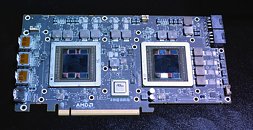Raevenlord
News Editor
- Joined
- Aug 12, 2016
- Messages
- 3,755 (1.24/day)
- Location
- Portugal
| System Name | The Ryzening |
|---|---|
| Processor | AMD Ryzen 9 5900X |
| Motherboard | MSI X570 MAG TOMAHAWK |
| Cooling | Lian Li Galahad 360mm AIO |
| Memory | 32 GB G.Skill Trident Z F4-3733 (4x 8 GB) |
| Video Card(s) | Gigabyte RTX 3070 Ti |
| Storage | Boot: Transcend MTE220S 2TB, Kintson A2000 1TB, Seagate Firewolf Pro 14 TB |
| Display(s) | Acer Nitro VG270UP (1440p 144 Hz IPS) |
| Case | Lian Li O11DX Dynamic White |
| Audio Device(s) | iFi Audio Zen DAC |
| Power Supply | Seasonic Focus+ 750 W |
| Mouse | Cooler Master Masterkeys Lite L |
| Keyboard | Cooler Master Masterkeys Lite L |
| Software | Windows 10 x64 |
Linux patches have already given us a "lot" of information (using "lot" generously there) on AMD's upcoming Vega graphics cards. I'd wager few enthusiasts would be looking towards a dual-GPU solution anymore - not with the mostly absent support from most recent games, of which Prey is a notable exception. Not unless there was some sort of hardware feature that exposed both dies as a single GPU for games and software to handle, but I'm entering the realm of joyous, hopeful thinking here.
Back to the facts, a May 10th Linux patch has added two more device ID's to a Vega family of products: 0x6864 and 0x6868. These additions bring the total number of Vega device ID's to a healthy 9, which is still less than Polaris' 12. This is in-line with the expected number of SKUs for Vega, which should be less than those available for Polaris.


There are two particular lines of code that suggest the involvement of liquid cooling:
For me, this reads as some sort of temperature thresholds, and isn't a given for the existence of two chips. The "Tliquid1Limit" and "Tliquid2Limit" could point towards the same temperature threshold for two different GPUs, or two different thresholds for a single GPU, where these temperature limits trigger a check on a pre-configured TDP table with values for cooling curves, for example. However, there is one more detail that could give a little push towards the dual-GPU hypothesis, which is this line here:
Now, Plx could mean PLX, as in, the ASIC bridge ship that is usually used to connect two different GPUs inside a single graphics card, circumventing PCIe lane restrictions usually found on platforms, and routing their signals to the PCIe slot. These chips actually do heat up as well, so it wouldn't be outside the realm of possible for a particular line of code that guarantees fan speed increase solely based on the PLX chip's temperature. However, these are just the most plausible interpretations for what is still unfortunately still shrouded in mystery. It's strange to see AMD so quiet in the short months still left for their Vega Q2 launch, but hopefully, we'll see something more tangible next week.

View at TechPowerUp Main Site
Back to the facts, a May 10th Linux patch has added two more device ID's to a Vega family of products: 0x6864 and 0x6868. These additions bring the total number of Vega device ID's to a healthy 9, which is still less than Polaris' 12. This is in-line with the expected number of SKUs for Vega, which should be less than those available for Polaris.


There are two particular lines of code that suggest the involvement of liquid cooling:
- table->Tliquid1Limit = cpu_to_le16(tdp_table->usTemperatureLimitLiquid1);
- table->Tliquid2Limit = cpu_to_le16(tdp_table->usTemperatureLimitLiquid2);
For me, this reads as some sort of temperature thresholds, and isn't a given for the existence of two chips. The "Tliquid1Limit" and "Tliquid2Limit" could point towards the same temperature threshold for two different GPUs, or two different thresholds for a single GPU, where these temperature limits trigger a check on a pre-configured TDP table with values for cooling curves, for example. However, there is one more detail that could give a little push towards the dual-GPU hypothesis, which is this line here:
- table->FanGainPlx = hwmgr->thermal_controller. advanceFanControlParameters.usFanGainPlx;table->TplxLimit = cpu_to_le16(tdp_table->usTemperatureLimitPlx);
Now, Plx could mean PLX, as in, the ASIC bridge ship that is usually used to connect two different GPUs inside a single graphics card, circumventing PCIe lane restrictions usually found on platforms, and routing their signals to the PCIe slot. These chips actually do heat up as well, so it wouldn't be outside the realm of possible for a particular line of code that guarantees fan speed increase solely based on the PLX chip's temperature. However, these are just the most plausible interpretations for what is still unfortunately still shrouded in mystery. It's strange to see AMD so quiet in the short months still left for their Vega Q2 launch, but hopefully, we'll see something more tangible next week.

View at TechPowerUp Main Site







